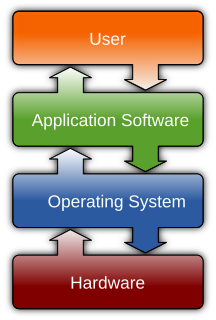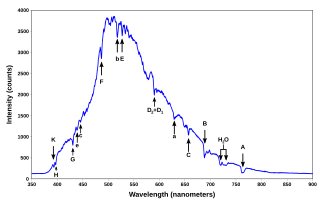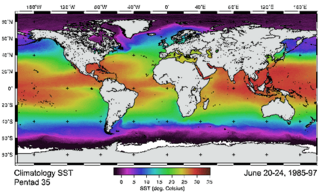4A/OP or, Automatized Atmospheric Absorption Atlas, is an operational fast and accurate radiative transfer model for the infrared.
Radiative transfer is the physical phenomenon of energy transfer in the form of electromagnetic radiation. The propagation of radiation through a medium is affected by absorption, emission, and scattering processes. The equation of radiative transfer describes these interactions mathematically. Equations of radiative transfer have application in a wide variety of subjects including optics, astrophysics, atmospheric science, and remote sensing. Analytic solutions to the radiative transfer equation (RTE) exist for simple cases but for more realistic media, with complex multiple scattering effects, numerical methods are required. The present article is largely focused on the condition of radiative equilibrium.

Infrared radiation (IR), sometimes called infrared light, is electromagnetic radiation (EMR) with longer wavelengths than those of visible light, and is therefore generally invisible to the human eye, although IR at wavelengths up to 1050 nanometers (nm)s from specially pulsed lasers can be seen by humans under certain conditions. IR wavelengths extend from the nominal red edge of the visible spectrum at 700 nanometers, to 1 millimeter (300 GHz). Most of the thermal radiation emitted by objects near room temperature is infrared. As with all EMR, IR carries radiant energy and behaves both like a wave and like its quantum particle, the photon.
Contents
4A/OP is a user-friendly software for various scientific applications (surface, balloon or space-based observations), co-developed by LMD (Laboratoire de Meteorologie Dynamique) and NOVELTIS with the support of CNES (the French Space Agency).

Computer software, or simply software, is a collection of data or computer instructions that tell the computer how to work. This is in contrast to physical hardware, from which the system is built and actually performs the work. In computer science and software engineering, computer software is all information processed by computer systems, programs and data. Computer software includes computer programs, libraries and related non-executable data, such as online documentation or digital media. Computer hardware and software require each other and neither can be realistically used on its own.

The National Centre for Space Studies (CNES) is the French government space agency. Its headquarters are located in central Paris and it is under the supervision of the French Ministries of Defence and Research.
NOVELTIS is in charge of the industrialization and the distribution of the LMD 4A radiative transfer model. 4A allows fast and accurate computation of transmittance and radiance, owing to the use of a comprehensive database (atlases) of monochromatic optical thicknesses for up to 43 atmospheric molecular species. Precomputed once and for all, the atlases are created by using the line-by-line and layer-by-layer model, STRANSAC, with up to date physics. Owing to the computation of Jacobians (partial derivatives of the radiance with respect to atmospheric variables), the 4A model can be easily coupled with an inversion algorithm for the retrieval of atmospheric temperature or composition from infrared radiance measurements.

Transmittance of the surface of a material is its effectiveness in transmitting radiant energy. It is the fraction of incident electromagnetic power that is transmitted through a sample, in contrast to the transmission coefficient, which is the ratio of the transmitted to incident electric field.
In radiometry, radiance is the radiant flux emitted, reflected, transmitted or received by a given surface, per unit solid angle per unit projected area. Spectral radiance is the radiance of a surface per unit frequency or wavelength, depending on whether the spectrum is taken as a function of frequency or of wavelength. These are directional quantities. The SI unit of radiance is the watt per steradian per square metre, while that of spectral radiance in frequency is the watt per steradian per square metre per hertz and that of spectral radiance in wavelength is the watt per steradian per square metre, per metre —commonly the watt per steradian per square metre per nanometre. The microflick is also used to measure spectral radiance in some fields. Radiance is used to characterize diffuse emission and reflection of electromagnetic radiation, or to quantify emission of neutrinos and other particles. Historically, radiance is called "intensity" and spectral radiance is called "specific intensity". Many fields still use this nomenclature. It is especially dominant in heat transfer, astrophysics and astronomy. "Intensity" has many other meanings in physics, with the most common being power per unit area.

A database is an organized collection of data, generally stored and accessed electronically from a computer system. Where databases are more complex they are often developed using formal design and modeling techniques.
It uses spectroscopy from the regularly updated GEISA spectral line data catalog. Other spectroscopy databanks can be used.

Spectroscopy is the study of the interaction between matter and electromagnetic radiation. Historically, spectroscopy originated through the study of visible light dispersed according to its wavelength, by a prism. Later the concept was expanded greatly to include any interaction with radiative energy as a function of its wavelength or frequency, predominantly in the electromagnetic spectrum, though matter waves and acoustic waves can also be considered forms of radiative energy; recently, with tremendous difficulty, even gravitational waves have been associated with a spectral signature in the context of LIGO and laser interferometry. Spectroscopic data are often represented by an emission spectrum, a plot of the response of interest as a function of wavelength or frequency.
GEISA - GEISA is a computer-accessible spectroscopic database, designed to facilitate accurate forward radiative transfer calculations using a line-by-line and layer-by-layer approach. It was started in 1974 at Laboratoire de Météorologie Dynamique (LMD) in France. GEISA is maintained by the ARA group at LMD for its scientific part and by the ETHER group at IPSL for its technical part. Currently, GEISA is involved in activities related to the assessment of the capabilities of IASI through the GEISA/IASI database derived from GEISA.

A spectral line is a dark or bright line in an otherwise uniform and continuous spectrum, resulting from emission or absorption of light in a narrow frequency range, compared with the nearby frequencies. Spectral lines are often used to identify atoms and molecules. These "fingerprints" can be compared to the previously collected "fingerprints" of atoms and molecules, and are thus used to identify the atomic and molecular components of stars and planets, which would otherwise be impossible.
The 4A/OP software is a version of the 4A code for distribution to registered users. This version is regularly updated and improved and contains a graphical user interface and a reference documentation.

The graphical user interface is a form of user interface that allows users to interact with electronic devices through graphical icons and visual indicators such as secondary notation, instead of text-based user interfaces, typed command labels or text navigation. GUIs were introduced in reaction to the perceived steep learning curve of command-line interfaces (CLIs), which require commands to be typed on a computer keyboard.
This software is used by several research groups and can be integrated in operational processing chains.[ citation needed ] In particular, 4A/OP is the reference radiative transfer model for the CNES/EUMETSAT Infrared Atmospheric Sounder Interferometer (IASI) level 1 Cal/Val and level 1 operational processing.




